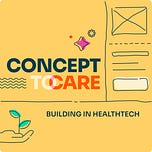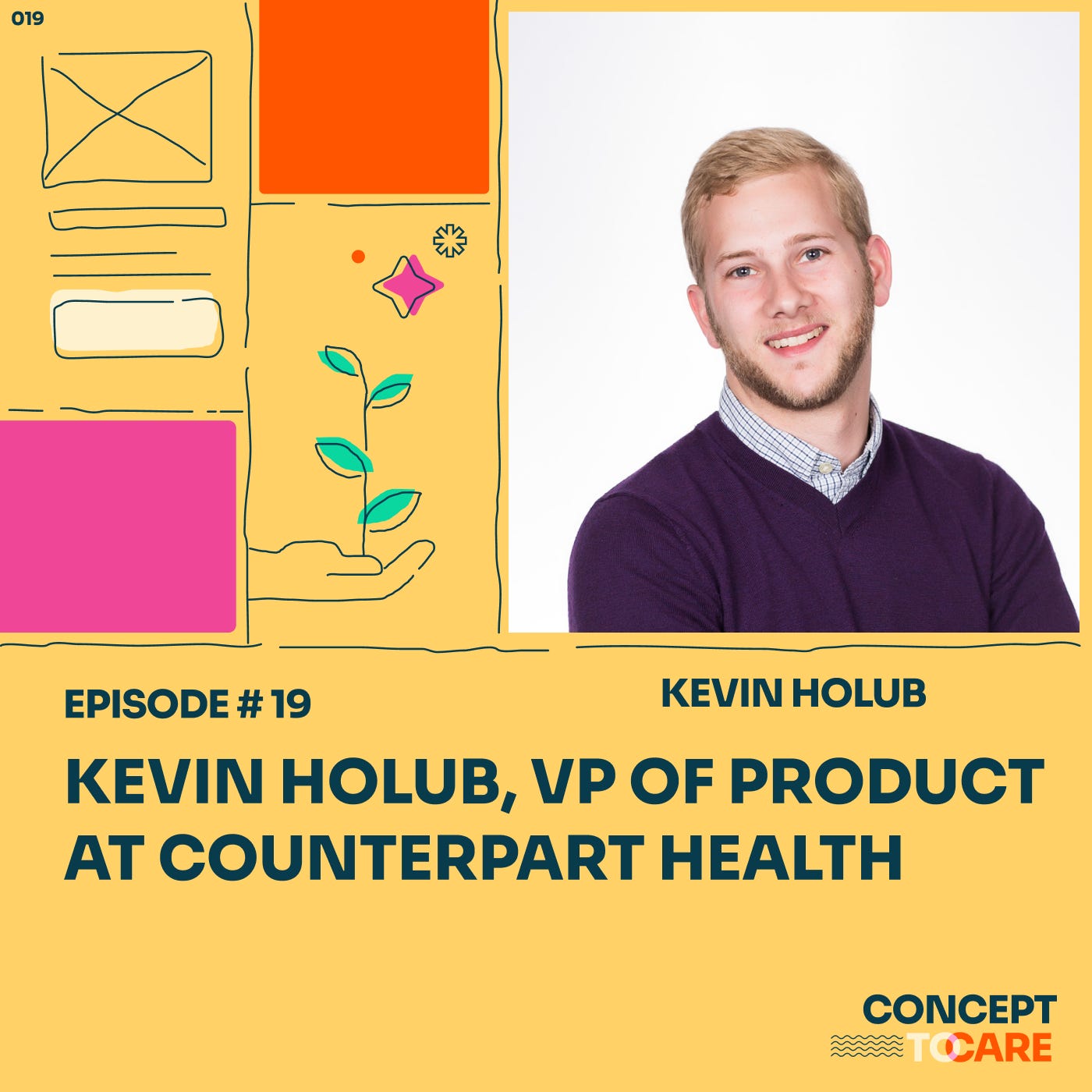Kevin Holub is the Vice President of Product at Counterpart Health, a company spun out of Clover Health to scale its flagship clinical decision support platform, Clover Assistant. With a background in product leadership, data, and clinical systems, Kevin has spent the last six years driving outcomes at the intersection of technology, value-based care, and primary care transformation. At Counterpart, he’s helping risk-bearing providers and payers harness proven tools to detect chronic disease earlier, improve quality scores, and reduce medical costs—while designing product teams that are empowered, outcome-driven, and ready to navigate the realities of healthcare complexity.
In our conversation, Kevin shares his insights on:
From Internal Tool to Scalable Business: How Clover Assistant became the foundation for Counterpart Health, enabling risk-bearing organizations to scale physician-support technology beyond a single health plan.
Building an Empowered Product Org: Lessons from Clover’s shift away from feature factory culture and how product teams earn autonomy through evidence and outcomes.
Balancing Long-Term ROI in Healthcare: How Kevin uses frameworks like McKinsey’s Three Horizons to prioritize in an environment where impact often takes years to show up on a P&L.
Growing Through Compounded Context: Why staying in one organization for the long haul can be the greatest accelerant for product leadership growth.
Getting Unstuck in a Feature Factory: Practical, high-leverage tactics for PMs trying to bring experimentation and autonomy into top-down orgs.
AI and the Future of Product Management: Kevin’s take on how generative AI is shifting the role of the PM—and how his team is organizing around short-term impact and long-term disruption.
What’s Next for Counterpart: Why Counterpart is leaning into flexible partnerships, customer learning, and clinical reach to serve providers across diverse care settings.
In this latest episode of Concept to Care, we had an engaging conversation with Kevin Holub, Vice President of Product at Counterpart Health, a company bringing Clover Health’s proven clinical technology to providers and payers nationwide. Kevin shared deep insights into his journey scaling a product inside a Medicare Advantage plan, the evolution of empowered product teams in healthcare, how to prioritize when impact is delayed, and what it takes to grow as a strategic product leader in a complex, outcomes-driven environment.
Some takeaways:
From Internal Tool to Scalable Business: How Clover Assistant Became Counterpart Health: Clover Assistant began as an internal tool powering Clover Health’s Medicare Advantage plan—and its success sparked the launch of Counterpart Health, a standalone tech subsidiary now serving payers, provider groups, and health systems nationwide.
What Clover Assistant does: A clinical decision support platform that integrates into physician workflows, enabling earlier diagnosis and treatment of chronic conditions like diabetes and CKD.
Proven impact: Clover Assistant enabled detection of diabetes 3 years earlier and CKD 1.5 years earlier on average—contributing to a sub-80% MCR and near-perfect HEDIS score of 4.94.
Why Counterpart was created: As Clover’s plan performance improved, the team realized the same tools could benefit other risk-bearing entities—leading to the formation of Counterpart Health as a separate brand and legal entity.
Strategic positioning: Counterpart offers the credibility of audited plan-level impact with the operational flexibility of a tech vendor—working with customers across models including SaaS, VBC partnerships, and risk enablement.
Who they serve today: Counterpart now supports a range of partners, including Duke Connected Care, The Iowa Clinic, and Southern Illinois Health.
From Feature Factory to Empowered Product Org: Lessons in Evolution: Kevin walked us through Clover’s transition from founder-driven execution to outcome-driven product development, starting with one pod and growing from there.
Where they started: Product was founder-driven and execution-focused—a classic “feature factory.”
How they evolved: By running AB tests, investing in instrumentation, and slowly earning trust, they transitioned to outcome-driven product teams.
Empowerment defined: Not carte blanche, but aligned autonomy—clear objectives, defined guardrails, and responsibility for moving key outcomes.
What made it possible: Starting small, measuring rigorously, and proving that the people closest to the problem could best solve it.
Balancing Long-Term Outcomes with Short-Term Action: The Product Manager’s Dilemma: In healthcare, some of the most meaningful product bets (like quality performance) won’t pay off financially for years—so PMs need tools to navigate multiple time horizons.
The lag of healthcare ROI: Some investments (like improving HEDIS scores) won’t financially show up for 2–3 years.
Framework used: Kevin applies McKinsey’s Three Horizons to guide team focus across short-term optimization, medium-term platform building, and long-term disruptive innovation.
Practical advice: Don’t lock into a static roadmap. Iterate continuously based on learnings.
Output ≠ outcome: PMs need to manage both the clinical impact and business metrics—especially in environments with delayed payback.
Career Growth through Compounding Knowledge: Kevin credits his rise from Senior PM to VP of Product to the power of staying, learning, and compounding hard-won context inside a complex domain.
Kevin’s journey: From Senior PM to VP of Product over six years, by incrementally expanding scope and learning deeply across product, data, and clinical workflows.
His advice: The most underrated growth lever is compounding knowledge—staying in one place long enough to build true context and credibility.
The warning: Switching jobs too frequently resets your context and slows your trajectory. “Every time you leave, you start over at zero.”
What made the difference: The right company, the right moment, and leadership willing to invest in internal growth.
Tactical Advice for PMs in a Feature Factory: If you’re stuck in a top-down product org, Kevin recommends starting with a metric, a test, and a very small win—and using that to build credibility over time.
Start small: Identify one metric that matters and run lightweight experiments to improve it.
Get leadership buy-in: Don’t try to go rogue—align leadership around testing a new way of working.
Prove and expand: Success earns trust. One win becomes a blueprint for the broader organization.
Structure discovery: Use clinical teams, customer success, and internal experts to compensate for limited access to time-strapped users like PCPs.
Rethinking Product Management in the Age of Generative AI: Kevin shared how generative AI is changing not only how teams build, but also what skills define great product managers in a world of rapid technological shifts.
Strategic framing: Kevin uses the Three Horizons model to guide product org focus—encouraging most PMs to live in Horizon 1 (next 6–12 months) while ensuring the company is thinking ahead to Horizons 2 and 3.
Horizon 1 (short-term): Product teams are expected to ship features that incorporate GenAI where it’s practical today—improving clinical efficiency, documentation, or workflow simplicity.
Horizon 2 (mid-term): Teams explore use cases like AI agents in clinical workflows—work that may not ship now but informs how the platform should evolve.
Horizon 3 (long-term): A dedicated leadership track explores disruptive scenarios like AGI and what happens “when Dr. Google becomes real,” focusing on organizational learning over output.
Skill shift for PMs: In this new environment, Kevin emphasized adaptability, strategic range, and domain literacy—PMs must stay grounded in the present while developing fluency in how tech might reshape their market.
What’s Next for Counterpart Health: Growth, Customization, and Strategic Learning: Kevin shared that Counterpart is entering a phase of accelerated growth, driven by new customer demand, flexible go-to-market pathways, and continued investment in clinical technology.
Public results as validation: Counterpart’s strong performance within Clover is fueling inbound interest from payers, providers, and risk-bearing organizations seeking similar results.
Momentum and expansion: Expect more announcements soon—new pilots, new customers, and new use cases aimed at delivering better care for more members.
Go-to-market flexibility: Counterpart is engaging creatively with a range of organizations, offering solutions as a SaaS vendor, risk partner, or technology collaborator.
PMF in motion: Kevin emphasized that while they’ve found product-market fit, they’re still discovering the most scalable and effective commercial model through experimentation.
Long-term goal: Enable physicians across diverse care settings—especially those in underserved or rural environments—to provide better, data-driven care with less burden.
—
Where to find Kevin Holub
LinkedIn: https://www.linkedin.com/in/kevinholub/
email: kevin.holub@cloverhealth.com
Counterpart Health: https://www.counterparthealth.com/
—
Where to find Angela and Omar:
Angela Suthrave
Omar Mousa
—
Referenced:
Counterpart Health: https://www.counterparthealth.com/
Clover Health: https://www.cloverhealth.com/
Clover Assistant: https://www.cloverassistant.com/
McKinsey’s Three Horizons Framework: https://www.mckinsey.com/capabilities/strategy-and-corporate-finance/our-insights/enduring-ideas-the-three-horizons-of-growth
LNO Framework Explained By Shreyas Doshi: https://www.dualoop.com/blog/shreyas-doshi-the-lno-effectiveness-framework
Value-Based Care (VBC): https://www.cms.gov/priorities/innovation/key-concepts/value-based-care
Medicare Advantage (MA): https://medicareadvocacy.org/medicare-info/medicare-advantage/
HEDIS Measures: https://www.ncqa.org/hedis/
STAR Ratings: https://www.ncoa.org/article/medicare-star-ratings/
Medical Cost Ratio (MCR): https://www.investopedia.com/terms/m/medical-cost-ratio.asp
Total Cost of Care (TCOC): https://www.cms.gov/priorities/innovation/key-concepts/total-cost-care-and-hospital-global-budgets
ICHRA (Individual Coverage HRA): https://www.healthcare.gov/job-based-help/ichra/
Clinical Decision Support (CDS): https://www.healthit.gov/topic/safety/clinical-decision-support
Arc Browser: https://arc.net/
Mode Analytics: https://mode.com/
—
Check out our website: https://www.concepttocare.com
Follow us and Subscribe wherever you get your podcast:















Share this post